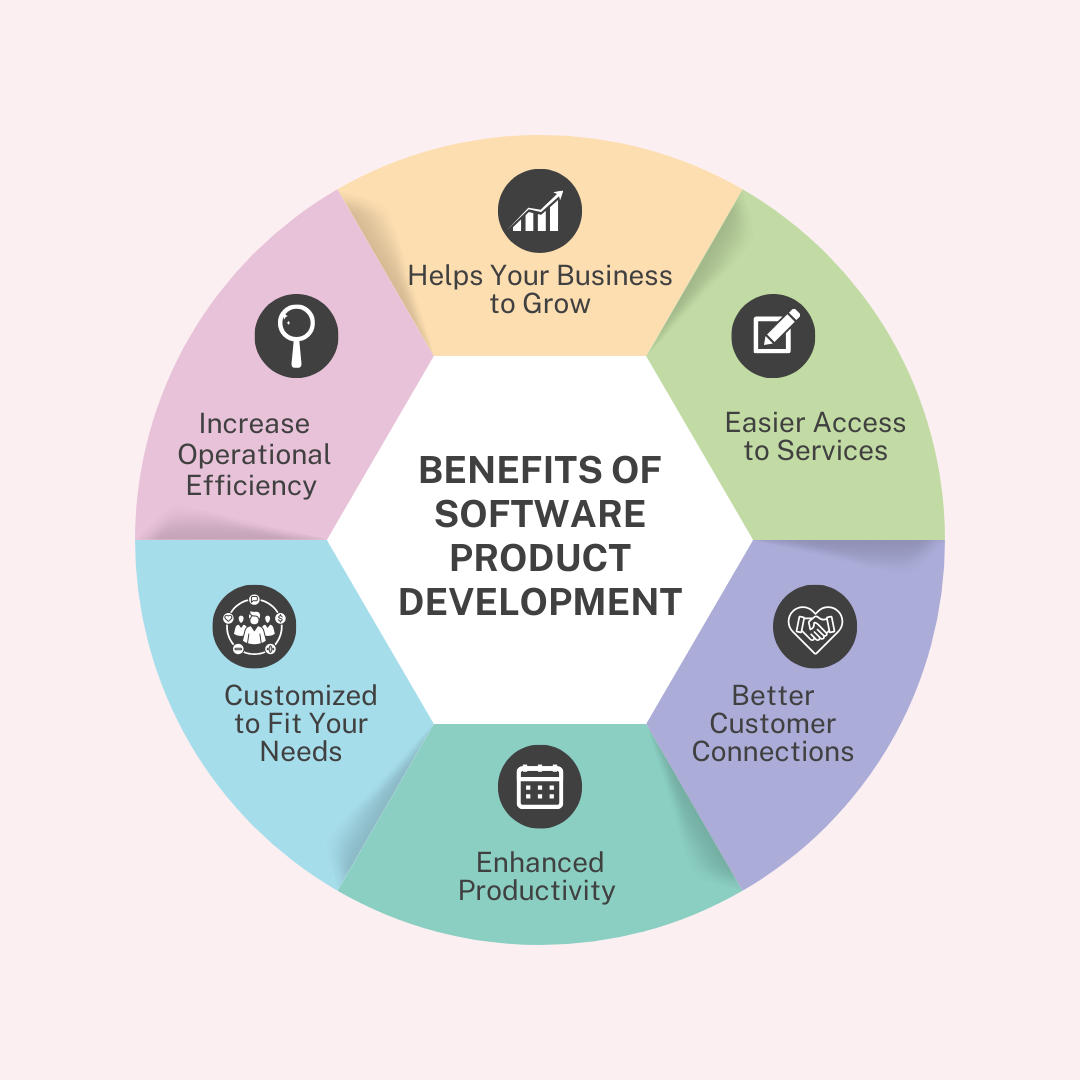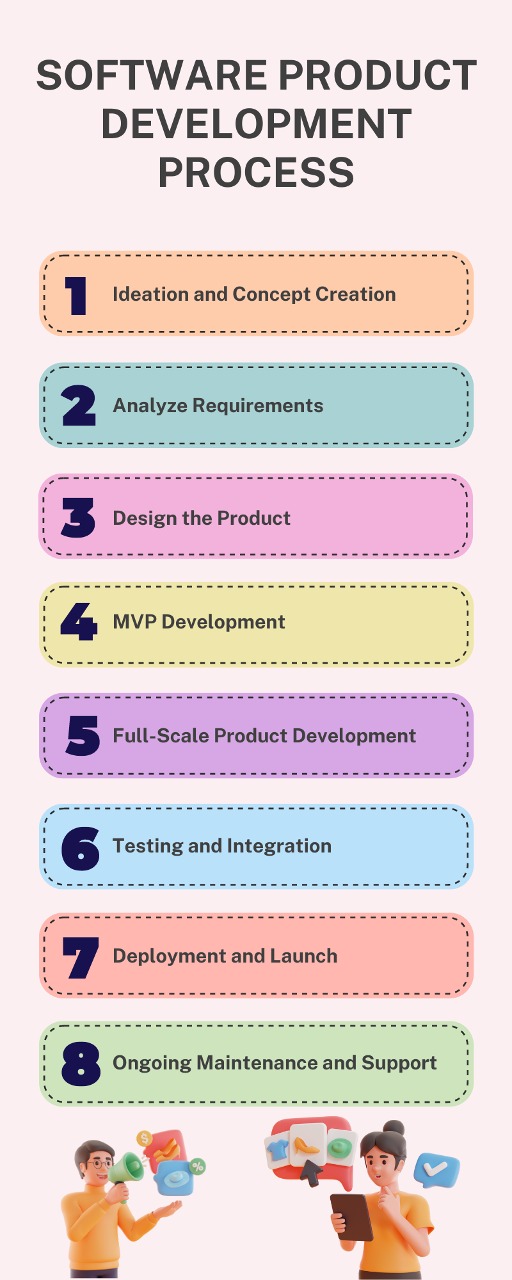Success rates for software projects are all over the place. According to BCG estimates, 70% of digital transformation initiatives fail to achieve their goals. This demonstrates how challenging it can be to execute large-scale digital products successfully. The Standish Group’s 2020 CHAOS report further reinforces this by stating that nearly 66% of software projects fail due to poor change management. While industry reports differ, the consensus remains clear–the odds are not in favor.
The above statistics are concerning, especially given the crucial role that IT and software solutions play in shaping how we work and live today. Globally, enterprises are facing difficulties related to legacy systems, protracted development cycles, and high maintenance costs. The outcome is missed deadlines, bloated budgets that stifle innovation, and products that fail to meet user expectations. This is where developing unique software products comes in handy.
Software product engineering services enable businesses to adjust rapidly and provide solutions that adapt to their clients’ changing demands. Utilizing state-of-the-art techniques may help you streamline processes, reduce waste, and launch products 60% quicker than conventional methods.
What is Software Product Development?
Software product development is the process of creating a new software product with added functionalities and value. It might include creating a new product, updating an old one, or refining the system’s process, method, or development methodology.
Software developers create solutions catering to specific market demands, incorporating third-party features and tools. This enhances current procedures, approaches, methods, and the user experience. To improve customer experience, existing manufacturing methods, procedures, techniques, and systems may all be updated.
What are the Benefits of Software Product Development?
Custom software development gives your business a competitive advantage over rivals by enhancing user experiences and providing scalability to adapt to future growth and changes.

The following are the benefits of software product development—
Helps Your Business Grow
Adhering to a software product development strategy facilitates seamless internal operations within your organization. It allows you to create effective plans and follow system specifications, which optimizes business processes.
Additional ways that end-to-end software development fosters corporate expansion are as follows:
-
Easier access to services
Software products’ accessibility across borders enables you to expand your brand, reach new markets and customers, and boost sales.
-
Better customer connections
Develop products that give your customers more significant support and service. This will boost sales and ROI while providing brand loyalty and customer satisfaction.
-
Enhanced Productivity
Automate repetitive and time-consuming processes to free up time and resources and enable your team to be productive in other workplace areas. Automation reduces expenses, saves time, and uses resources more efficiently.
Customized to Fit Your Needs
Innovative software meets a particular audience’s demands. Since no two businesses are alike, what works for one might not suit yours. Software may assist you in realizing your business’s vision, no matter what it is.
Using a customized approach to software product development, you may build software to handle your procedures and operations. At the same time, it may be good to use standardized, prepackaged software that satisfies some or perhaps most of your demands. Full-cycle software development can give you the edge to stand out.
Some advantages of using custom software product solutions are—
- Increased process efficiency
- Goal-driven solutions
- Quicker outcomes
Increase Operational Efficiency
Software product development may streamline productivity in several ways. A product development company is capable of automating time-consuming operations in addition to—
- Boost teamwork by using new-age technologies.
- Enable software to be built, tested, and deployed with a CI/CD approach.
- Adhere to industry standards and best practices to ensure the software is of the highest caliber, trustworthy, and easy to maintain.
- Streamline productivity using methodologies like Agile and DevOps.
Breaking Down the Software Product Development Process
Explore the essential stages of the software product development process, from ideation to deployment, ensuring successful outcomes for your project.

Ideation and Concept Creation
Product idea generation is the initial phase of software development. During this phase, the software development team generates concepts for a new product that tackles a common issue or fulfills a market demand.
POC development services perform several tasks to obtain this information, including market research, gap analysis of existing software products, and client feedback analysis. In addition to these aspects, the team considers income potential, competition, and market size.
In contrast to other phases, the product idea creation stage is critical because it determines the course and extent of the product development process.
Consequently, you must include all pertinent parties and stakeholders in this phase. This will ensure that the product concept meets the market and company’s demands.
Analyze Requirements
As its name implies, the requirement analysis phase entails obtaining and documenting the product’s functional and non-functional needs.
At this phase, the development team learns the end users’ requirements. They also consider market trends, company objectives, and technological limitations when gathering requirements.
The following tasks are commonly included in the requirement analysis stage–
-
Requirement Gathering—
The team gathers client, end user, and stakeholder needs using workshops, surveys, interviews, and other methods. Functional requirements refer to what the product should accomplish, whereas non-functional requirements describe how the product should work.
-
Requirement Analysis—
The product discovery & strategy team gathers and examines requirements to find gaps, ambiguities, or contradictions. Additionally, they rank every criterion according to its significance, viability, and effect on the final output.
-
Requirement Documentation—
After completing the requirement analysis, the team documents to finalize requirements in a formal document (such as a software requirements specification).
After completing these tasks, the team reviews the requirements for gaps or discrepancies. If any are discovered, they are fixed before proceeding to the next phase.
Design the Product
In this stage, they determine the product’s architecture and design. A blueprint outlines the software product’s look, feel, and user experience.
The following are the primary tasks to complete throughout the product design phase—
-
Architectural Design—
Develop a high-level design that describes the product’s essential parts and how they interact with one another. Consider non-functional needs, including speed, scalability, and security.
-
Component Design—
Build a thorough design for every component, including the database, application logic, and user interface. The design should outline each element’s functionality, the algorithms used, and the interfaces that connect them.
-
Prototype Development–
UX/UI design & prototyping of your product to showcase its features and functionality. The prototype will collect input from stakeholders and end users and help validate the design.
-
MVP Design—
The team creates the front end of the essential features and functions that must be included during the design phase to satisfy the MVP (minimum viable product) criteria.
-
Review–
At last, an overall review is carried out to ensure that the software product design satisfies all needs and is practical to implement.
MVP Development
Usually, MVP development takes place during the design and development phases of the software development process.
The MVP is often a rudimentary software version that enables user feedback and enables the team to gradually refine and enhance the product through iterations.
Creating an MVP aims to bring a working product to users as soon as possible so that they can provide feedback and the product may be enhanced and iterated upon in response to their input.
Full-Scale Product Development
The software product development process revolves around the end-to-end product development stage.
Once the MVP is introduced to the market and receives favorable feedback from the early adopters, the development team begins creating the full-fledged software.
The product development stage takes the longest because it is the most critical and intricate step in the development process.
The development team follows the blueprint developed during the product design stage to build the actual software product.
The development team develops the code to implement the product design using industry-standard coding best practices. The team then uses various testing techniques to ensure the code satisfies the predetermined specifications and operates as intended.
Testing and Integration
Integration is a crucial step in the development of software products because it is at this phase that all separate components are brought together to create a single, coherent product.
Furthermore, the product satisfies every requirement, both functional and non-functional.
Here are the primary activities completed in this phase:
-
Component Integration—
Combine the separate software parts to create a more comprehensive package. This will make it easier to ensure that all the parts can interact and communicate with one another as intended.
-
System Integration—
Once the parts have been integrated, combine them into a single system and ensure they function as they should. If problems or glitches appear, look for solutions.
-
Acceptance Testing—
Once fully integrated, the system undergoes acceptance testing. By testing it against the criteria, you must verify that it satisfies all functional and non-functional needs.
Deployment and Launch
This step involves putting the product into a live environment, ensuring it functions as intended, and guaranteeing that people can access and utilize it.
There are many stages involved in software product deployment for end users: planning, preparation, execution, and monitoring.
- The planning phase develops a deployment strategy to ensure that the product is arranged and controlled and that any risks are recognized and handled.
- During the preparation phase, the product is rigorously tested to make sure all criteria are met and that any defects or difficulties have been found and fixed.
- The execution involves installing the software on the user’s devices or accessing it via servers or web apps.
- Lastly, the monitoring phase analyzes the product’s performance following deployment to ensure it operates as intended and that any problems or defects are promptly found and corrected.
Following deployment, the team will monitor the program’s functionality and provide updates to fix errors and enhance user experience.
Ongoing Maintenance and Support
The principal objective of the maintenance phase is to keep the software working after deployment.
There are two kinds of maintenance:
- Corrective
- Adaptive
Corrective maintenance aims to address defects or issues that appear after deployment. On the other hand, adaptive maintenance involves modifying the product to accommodate evolving technology, changing user demands, or other variables.
The development team regularly monitors the product and uses various tools to assess its performance and identify areas for improvement.
When an issue or defect is found, the team prioritizes and addresses it appropriately, delivering updates and bug fixes as needed to ensure the product functions seamlessly.
Innovation-Driven and Agile Software Development Methodologies
Now, let’s see how software development techniques improve flexibility, collaboration, and speed to build value-oriented products.
-
Waterfall
The waterfall methodology is a conventional, linear way of developing software products. It proceeds step-by-step, finishing each stage before proceeding to the next. Small projects with precise deliverables and well-defined criteria might benefit from this process. But it’s inappropriate for large, intricate projects that need flexibility.
Pros
- Structured development process
- Defined requirements upfront
- Comprehensive documentation
- Predictable timelines and budgets
Cons
- Inflexible to changes
- Late testing phase
- Assumes stable requirements
- Potential misalignment with needs
-
Agile
Agile software development methodology may reduce risks like potential defects, changing needs, and financial concerns. Agile teams build software products through iterations. Every iteration or increment expands upon the capability, enabling teams to evaluate each function as it is released.
Pros:
- Flexibility to Adapt
- Quickly identify and correct flaws
- Continuous Feedback Loops
- Provide early input on specific features
Cons:
- Depends on real-time communication, which leaves new users needing more documentation.
- Labor-intensive and requiring a significant time investment.
- Less predictable timelines
- Documentation may be lacking
-
Scrum
Scrum is an agile development methodology. You will make decisions based on experimentation, experience, and observation. Scrum operates on three pillars–adaptability, inspection, and transparency.
Pros:
- Complete project deliverables in a timely and efficient manner.
- Good in situations with rapid movement.
- Insightful feedback from stakeholders and customers.
- Developments in code and testing during sprint reviews
Cons:
- Scope creep
- Time-Consuming meetings
- A higher chance of project failure if individuals lack commitment
- Adoption of the Scrum framework may be challenging
-
DevOps
DevOps is a development methodology and a set of practices that guarantee better departmental and team communication, such as between software developers and quality assurance.
Pros:
- Shorter time to market
- Decreased failure rate in new releases
- Reduced intervals between fixes
- Reduced interference while enhancing dependability
Cons:
- Testing may miss flaws that are not found.
- Reduced precautionary measures
- It might be challenging to manage
- Potential for resource overlap
Hire a Product-focused Software Development Company for Your Project
Your business must keep up with the latest software procedures and practices to stay ahead of the competition and provide excellent customer service. Hire end-to-end software development services providers who see the value of remaining up-to-date in this ever-evolving industry. SparxIT is the leading software development company to transform your ideas into innovative solutions. Our expert team ensures high-quality, tailored development that accelerates your project’s success.

Partner with Experts
Frequently Asked Questions
How can I determine if my software product idea is viable?







You can easily determine if your software product concept is viable or not by considering various factors such as–
- Write down your objectives, expectations, and hypotheses.
- Marshall your product idea with your business plan.
- Evaluate market opportunity size and potential.
- Validate your concept with real users.
- Develop Prototypes and Mockups for visualization.
- Create, test, and iterate your MVP
What is the timeline for software product development?












The timeline varies based on various factors such as project scope (number of features, implementation difficulty), design complexity (customized UI, animations), integration, database migration, and development methodology. We set realistic deadlines to ensure timely delivery. Here is the average time for software development for businesses—
| Business Type | Timeline |
| Small business | 2 to 3 months |
| Mid-level business | 3 to 6 months |
| Enterprise business | 6 to 12 months or more |
Can my existing software systems be integrated into the new product?












Yes, we have expertise in integrating existing software systems with your current systems. Our developers also ensure seamless platform functionality to help businesses improve productivity and scalability and provide more access to value-driven and cognitive technologies.
How much does software product development cost?












The cost of software product development depends on project complexity, team expertise, development time, technology stack, and ongoing maintenance. Here’s an illustration of the cost of agile software product development—
| Type of Project | Costs |
| Small projects | $10,000 — $50,000 |
| Medium projects | $50,000 — $250,000 |
| Large projects | $250,000+ |
How can I ensure the security of my software product?












To achieve robust, future-ready security, consult a leading software product engineering services provider. SparxIT emphasizes security throughout the software development lifecycle by implementing stringent security testing, secure coding practices, regular updates, vulnerability management, and encryption.




